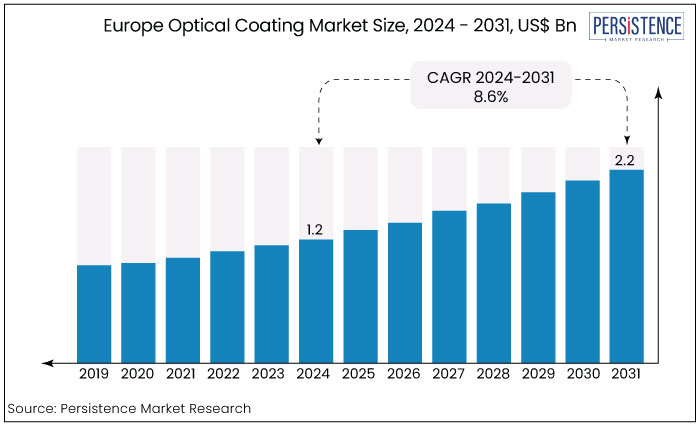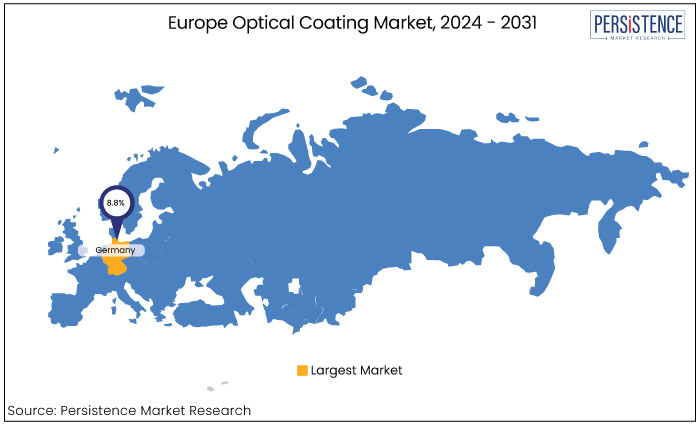Europe Optical Coating Market
Industry: Chemicals and Materials
Published Date: November-2024
Format: PPT*, PDF, EXCEL
Delivery Timelines: Contact Sales
Number of Pages: 171
Report ID: PMRREP34904
The Europe optical coating market is projected to witness a CAGR of 8.6% during the forecast period from 2024 to 2031. It is anticipated to increase from US$ 1.2 Bn recorded in 2024 to a considerable US$ 2.2 Bn by 2031. The regional market is experiencing significant growth, driven by a combination of regulatory pressures and technological innovations.
Stringent regulations focused on energy efficiency and sustainability are fostering demand for optical coatings. The European Union’s (EU) commitment to reducing carbon emissions further amplifies this demand, as industries seek to adopt green technologies. For instance, to lower average emissions, the EU has imposed strict CO2 emissions standards for new automobiles. New cars and vans must reduce their CO2 emissions by 15% by 2025 compared to 2021 levels, and by 50% for cars and 50% for vans by 2030.
The region’s robust automotive industry is further integrating unique optics into vehicle systems, creating a rising need for innovative optical coatings. Presence of well-established research institutions and a strong commitment to technological developments also play a key role in supporting optical coating technologies across various industries. Together, these factors are propelling the market in Europe into a new phase of expansion.

Key Highlights of the Market
|
Market Attributes |
Key Insights |
|
Europe Optical Coating Market Size (2024E) |
US$ 1.2 Bn |
|
Projected Market Value (2031F) |
US$ 2.2 Bn |
|
Europe Market Growth Rate (CAGR 2024 to 2031) |
8.6% |
|
Historical Market Growth Rate (CAGR 2019 to 2023) |
7.9% |
|
Country |
CAGR through 2031 |
|
Germany |
8.8% |
Germany is witnessing significant growth, driven by the country's robust automotive industry and increasing adoption of Electric Vehicles (EVs). According to the International Energy Agency (IEA), new electric car registrations in Europe reached nearly 3.2 million in 2023. Germany became the third country after China and the U.S. to record over half a million new battery electric car registrations in a single year.
About 18% of car sales in Germany were under the battery electric segment and an additional 6% were plug-in hybrids. Hence, there is a growing demand for unique optics and coatings in automotive applications, such as enhanced displays, sensors, and energy-efficient technologies.
The ongoing shift not only reflects the automotive industry’s evolution but also underscores the key role of optical coatings in supporting Germany's commitment to sustainability. The strong performance of the EV market is set to further drive demand for optical coatings, positioning Germany as a significant hub in future.

|
Category |
CAGR through 2031 |
|
Product- Reflective Coating |
8.9% |
Reflective coating is experiencing remarkable innovations, particularly in applications for autonomous vehicles. For instance,
In laboratory tests, the multilayer system has demonstrated low reflectance while maintaining excellent antifog properties. This made it highly suitable for environments where visibility is critical.
Beyond automotive applications, the technology holds promise for a variety of sectors, including lighting and quantum computing, as well as potential uses in diverse materials. As demand for cutting-edge reflective coatings grows, particularly in high-tech applications, the segment is poised for significant expansion and innovation.
|
Category |
CAGR through 2031 |
|
Technology- Vacuum Deposition |
8.6% |
Vacuum deposition is a key technology in the Europe optical coating industry. It uses methods like Physical Vapor Deposition (PVD) and Chemical Vapor Deposition (CVD) to apply thin films onto substrates. The process operates in a vacuum environment, minimizing contamination and allowing for high-purity coatings. It also provides precise control over film thickness, which is essential for achieving desired optical properties.
The high versatility of vacuum deposition makes it suitable for various materials. It enables applications in anti-reflective coatings for lenses, filters for cameras and sensors, and reflective coatings in solar panels and mirrors, driving innovation across multiple industries.
|
Category |
CAGR through 2031 |
|
End Use- Automotive |
8.7% |
By end use, the automotive industry is experiencing significant growth, driven by rising production and sales of vehicles. In 2023, the European Union (EU) car market surged by 13.9% compared to 2022, reaching a volume of 10.5 million units. Key markets like Italy (+18.9%), Spain (+16.7%), France (+16.1%), and Germany (+7.3%) contributed to this growth.
A significant aspect of the automotive industry is the surging Electric Vehicle (EV) adoption. New electric car registrations in Europe reached 3.2 million in 2023, marking a nearly 20% increase from the previous year.
In the EU, total EV sales reached 2.4 million, indicating strong demand. Germany stands out as a leader, recording over half a million new battery electric vehicle registrations in a single year, with 18% of car sales being battery electric and an additional 6% being plug-in hybrids.
Rapid transition to EVs necessitates unique optical coatings for automotive applications, enhancing functionalities such as visibility, safety, and energy efficiency. As the automotive industry incorporates cutting-edge optics into vehicle systems, demand for high-quality optical coatings is expected to rise. It is projected to position the segment as a vital driver for innovation and expansion in Europe.
The Europe optical coating market is entering a transformative phase, driven by innovations in technology and increasing demand across various industries. Optical coatings help enhance the performance of optical components by reducing reflection. These further increase transmissions and improve durability.
Key applications span sectors such as automotive, aerospace, telecommunications, and renewable energy. With stringent regulations focused on energy efficiency and sustainability, the market is positioned for robust growth as industries seek advanced optical technologies.
The push for renewable energy sources, particularly solar power, is driving the need for effective optical coatings. These coatings are essential for improving the efficiency of solar panels and other energy systems.
Governments of various countries in Europe are actively promoting optical technologies through funding and regulatory support. Initiatives aimed at achieving climate goals are gaining momentum, thereby augmenting demand.
The Europe optical coating market recorded a considerable CAGR of 7.9% in the historical period from 2019 to 2023. Surging demand for EVs and a rapid shift toward solar energy accelerated optical coating sales during this period. Key players also invested huge sums in broadening their distribution channels as well as innovating existing products. For instance,
The global market is estimated to record a CAGR of 8.6% during the forecast period between 2024 and 2031. It is attributed to the increasing adoption of Head-Up Displays (HUDs) in today’s vehicles. The coatings help deliver a clear display under multiple lighting conditions. To reduce glare and improve visibility, anti-reflective and polarizing coatings are considered significant in the automotive industry.
Rapid Development of Solar Energy to Boost Demand in Future
Constant innovation in the field of solar energy is anticipated to push Europe optical coating market growth through 2031. Rapid expansion of the Solar Photovoltaic (PV) segment is mainly responsible for this growth. It is attributed to the rising emphasis on clean energy and surging demand for consumer electronics. Reflective coatings play a key role in various applications, including construction, telecommunications, and space, enhancing efficiency and performance.
In green buildings, reflective coatings are used for heat retention and energy consumption reduction, augmenting demand. Furthermore, rising popularity of portable consumer electronics, including handheld consoles, contributes to the need for unique optical coatings.
Initiatives like the European Green Deal and REPowerEU aim for a climate-neutral continent by 2050, significantly increasing solar capacity in countries, such as Germany and Spain. These frameworks provide substantial EU funding for solar projects and promote technological advancements, ultimately enhancing energy security and sustainability in Europe. The synergy between solar energy boom and optical coatings presents significant opportunities for market expansion. For instance,
Demand for Optical Black Coatings to Skyrocket from Healthcare Sector
Rising demand for superior functionality, durability, and precision in the healthcare sector is anticipated to push the market in Europe. Imaging systems for surgery and diagnosis are among the most important applications. For instance,
Devices used in minimally invasive treatments, where accurate imaging is essential to success, benefit greatly from anti-reflective coatings. Germany's investments in healthcare technologies, where high standards necessitate improved imaging quality, boost this demand.
Volatility in Prices of Indium, Copper, Gold, and Silver May Hinder Demand
A significant restraint on the Europe optical coating market is the high production cost driven by volatility in raw material prices. The manufacturing processes for optical coatings rely on various raw materials, including oxides like aluminum, zirconium, titanium, and selenium. These also include fluorides such as strontium and magnesium as well as metals like copper, gold, and silver.
The metal market is highly volatile, leading to substantial price fluctuations for key components such as titanium dioxide (TiO2), indium, gold, copper, and silver. The rare availability of these materials exacerbates this issue as rising prices directly impact manufacturing costs. For instance,
As manufacturers face increased raw material costs, they may struggle to maintain competitive pricing, potentially limiting growth and innovation in the regional market.
Optical Hard Coating Manufacturers to Target Consumer Electronics Brands
A significant opportunity for the Europe custom optical coatings industry lies in the rising demand from the electronics and semiconductor industry. Surging smartphone usage has been particularly notable, with local smartphone subscribers surpassing 496 million. It contributes to an economic value of approximately 910 Bn Euros, which is about 5% of Europe’s GDP.
The booming market creates a high need for unique optical coatings in various electronic devices, including smartphones, tablets, and wearables. These coatings help enhance functionalities such as display clarity, touch sensitivity, and anti-reflective properties. Hence, these are considered essential for modern consumer electronics.
As demand for more sophisticated and high-performance electronic devices continues to rise, manufacturers will likely seek innovative coatings to improve product performance and durability. This trend presents a lucrative opportunity for optical coating suppliers to extend their offerings and capture a high share of this dynamic market.
The Europe optical coating industry is competitive, featuring a mix of established global players, regional manufacturers, and specialized firms. Key drivers include technological innovation as companies are investing in advanced, eco-friendly coatings to meet industry demands, especially in automotive and renewable energy sectors.
The market is also exhibiting consolidation through mergers and acquisitions, enhancing capabilities and market presence. Regional variations in competition arise from local regulations and industrial focuses. Additionally, a customer-centric approach is gaining importance, with companies prioritizing tailored solutions and robust client relationships to succeed in this dynamic environment.
Recent Industry Developments
|
Attributes |
Details |
|
Forecast Period |
2024 to 2031 |
|
Historical Data Available for |
2019 to 2023 |
|
Market Analysis |
US$ Billion for Value |
|
Key Countries Covered |
|
|
Key Market Segments Covered |
|
|
Key Companies Profiled in the Report |
|
|
Report Coverage |
|
|
Customization and Pricing |
Available upon request |
By Product
By Technology
By End Use
By Country
To know more about delivery timeline for this report Contact Sales

The market is set to reach US$ 2.2 Bn by 2031.
The automotive industry is considered the target market.
Cutting Edge Coatings GmbH is considered the leading player in Europe.
It is a material deposited on optical elements, such as mirror or lens to change the way in which the element reflects or transmits light.
The coatings are mainly applied in bathrooms, aerospace, autonomous driving, and decorative glazing.